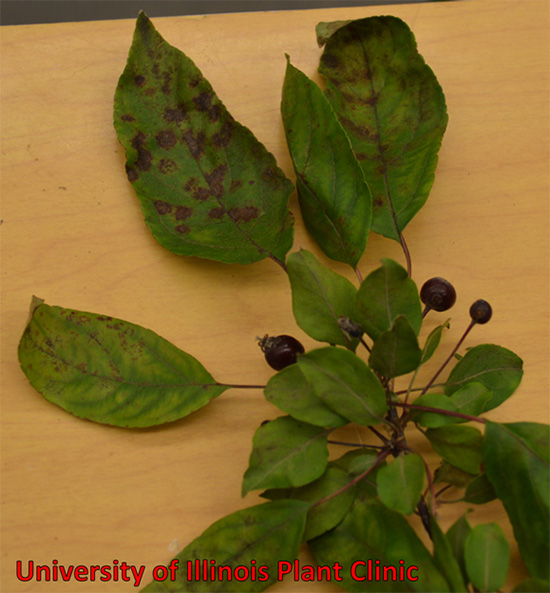Issue 7, June 6, 2016
Apple Scab
Apple scab is a common fungal disease that affects apple and crabapple trees. Initial infection occurs in spring during flowering, followed by repeating cycles of secondary infections that continue through the growing season.
We've started to get apple samples with scab already this year. Symptoms on leaves and fruit are the most noticeable, though lesions can appear on almost any non-woody, aerial part of the tree. On leaves, initial symptoms appear as lighter green spots that progress to dark olive green, often along or near leaf veins. Infected leaves may also deform by puckering or curling. As the disease progresses, infected leaves turn yellow and prematurely drop from the tree (usually by mid-summer). This early defoliation decreases the aesthetic value of the tree, and can weaken the tree. Fruits are frequently affected, with dark olive-brown spots progressing to cracked, black scabs on the surface of the apple. If infection occurs when the fruit are young, they will often become distorted as they develop.

Apple scab on crabapple. Note the circular, dark olive-brown lesions on the leaves.
The fungal pathogen overwinters on fallen infected leaves (it may also overwinter on buds, though this is less significant for the disease cycle). Typical spring weather (mild temperatures and rain) induces spore dispersal from fungal fruiting structures located on fallen leaves. These spores are borne by wind and rain splash into the canopy of nearby trees, where they infect apple blossoms and young leaves. Wet conditions are required for this primary infection. Spore dispersal occurs for several weeks in most years, from budbreak through the end of bloom. Once infection has occurred, a second type of spore is produced. These spores spread easily through wind and rain, and continuously infect new tissue. Warm, humid conditions favor spore development; cooler summers tend to result in less infection.
Management of apple scab is best achieved through multiple methods. Sanitation has been shown to be very effective at reducing disease the following year. Raking and removing leaves removes the pathogen from the environment, while mulching the leaves with a mower promotes leaf degradation which reduces overwinter survival of the pathogen. Either of these techniques is recommend to control the disease. Resistant varieties of both apple and crabapple are available, and should be considered if you are installing new trees. Spacing trees properly and pruning to increase air flow will reduce leaf wetness, which is required for initial infection in spring.
Fungicide sprays are available to protect new growth in spring from infection. The first application should be made when leaves begin to emerge from the buds in early spring. Sprays should be continued according to the labeled interval until 2 weeks after petal fall for maximum protection. If no leaf spots are seen at that time, fungicide treatments can be discontinued. The fungicide label may give a range of days between sprays as the labeled interval. In springs where there are frequent periods of wet weather or in areas with a history of scab, the shortest labeled interval should be used. Periods of dry weather and areas that have not been heavily affected with scab previously can be sprayed according to the longer interval. (Diane Plewa)
Author:
Diane Plewa